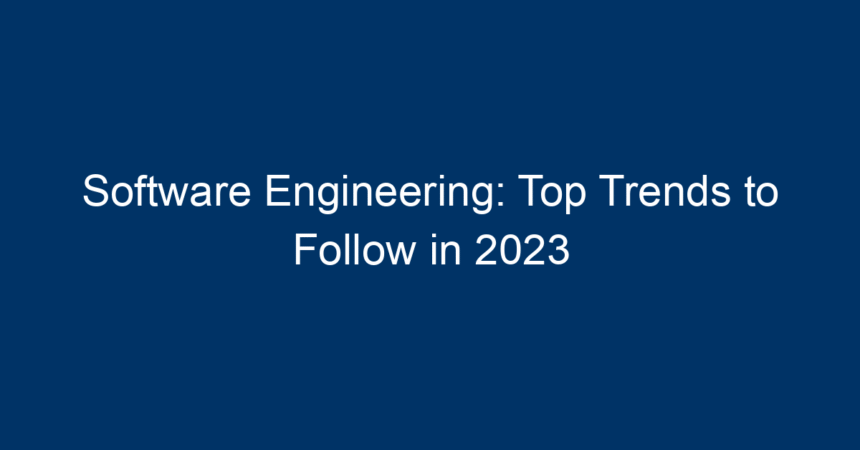In the fast-paced world of technology, the field of software engineering is constantly evolving. As we progress through 2023, certain trends have emerged that are shaping how developers design, deploy, and maintain software. Understanding these trends is crucial for professionals in the field to stay competitive and relevant. This article delves into the top software engineering trends you should follow this year.
The Rise of Artificial Intelligence
AI-Powered Development Tools
Artificial intelligence (AI) is no longer just a futuristic concept; it is now a practical tool that software engineers use daily. AI-powered tools and frameworks are streamlining the development process by automating repetitive tasks, enabling faster and more efficient coding. From code suggestions to bug detection, AI is transforming how developers work.
Machine Learning Integration
In 2023, machine learning is not just for data scientists. Software engineers are increasingly integrating machine learning models into applications. This integration provides enhanced functionality, allowing for predictive analytics, personalized user experiences, and improved decision-making processes.
Increased Focus on DevOps and Continuous Delivery
The DevOps Culture
As businesses aim for faster release cycles and higher-quality software, the DevOps culture is becoming indispensable. DevOps fosters collaboration between development and operations teams, breaking down silos and promoting a more agile approach to software engineering.
Continuous Integration/Continuous Deployment (CI/CD)
CI/CD practices have become standard in software engineering, allowing for more robust testing and quicker deployment. By automating the integration and delivery pipeline, software teams can ensure rapid, reliable releases, thus minimizing the risks associated with software updates.
Emphasis on Cybersecurity
Secure by Design
With the rise in cyber threats, software engineering practices are shifting towards a "secure by design" mindset. This entails embedding security measures throughout the software development lifecycle (SDLC). Software engineers are now more focused on identifying vulnerabilities early and implementing best practices in coding to mitigate risks.
Compliance and Privacy Regulations
The introduction of stringent data protection regulations, such as GDPR and CCPA, has necessitated a focus on compliance in software engineering. Developers must ensure that applications align with these regulations, emphasizing data privacy and security measures from the outset.
Cloud-Native Applications
Shift to the Cloud
The trend towards cloud-native application development is accelerating in 2023. By leveraging cloud services, software engineers can build scalable, resilient applications that can grow based on user demand. The ability to utilize microservices architecture and containerization technologies such as Docker and Kubernetes empowers developers to create dynamic, flexible applications more efficiently.
Serverless Computing
Serverless architectures are gaining traction, enabling developers to focus on writing code without worrying about server management. This approach allows for optimized resource allocation and cost-saving, which is a significant advantage for software engineering teams looking to streamline operations.
Enhanced User Experience Through UX Design
User-Centric Development
User experience (UX) has never been more critical in software engineering. In 2023, there is a concerted effort towards user-centric development, where software engineers collaborate closely with UX designers to ensure that applications meet user needs and expectations.
Advanced UI Frameworks
The evolution of user interface frameworks, such as React, Angular, and Vue.js, has made it easier for software developers to create responsive and interactive applications. By incorporating advanced UI components, developers can deliver richer user experiences that stand out in a crowded marketplace.
Focus on Cross-Platform Development
One Codebase, Multiple Platforms
Cross-platform development is a trend that continues to gain momentum in 2023. Frameworks like Flutter and React Native allow software engineers to write code once and deploy it across multiple platforms, saving time and resources. This approach not only accelerates development cycles but also ensures consistent user experiences across devices.
The Importance of Performance Optimization
While cross-platform frameworks ease development, software engineers must still focus on performance optimization. Ensuring that applications run smoothly across all platforms is essential for maintaining user satisfaction and achieving business goals.
Rising Popularity of Low-Code and No-Code Platforms
Democratizing Software Development
The rise of low-code and no-code platforms is revolutionizing software engineering by democratizing the development process. These platforms enable non-developers to create applications with minimal coding knowledge, empowering teams to prototype and iterate swiftly.
Speeding Up Development
For software engineers, low-code platforms can significantly expedite development workflows. By using these tools for routine tasks, developers can focus on more complex problems, enhancing productivity and innovation within teams.
The Importance of Agile Methodologies
Agile in Software Engineering
Agile methodologies have become a staple in software engineering. The iterative approach facilitates continuous improvement and adaptability, allowing teams to respond to changes more effectively. As requirements evolve, agile practices ensure that the final product aligns with user needs.
Scrum and Kanban Frameworks
Scrum and Kanban frameworks are among the most popular agile methods being adopted in 2023. These frameworks emphasize collaboration, transparency, and adaptability, which are essential for successful software development.
Actionable Insights for Software Engineers
As we navigate through the landscape of software engineering in 2023, keeping abreast of these trends is crucial. Here are some actionable insights to help you succeed:
-
Invest in Learning AI Tools: Familiarize yourself with AI-powered development tools that can automate routine tasks and improve coding efficiency.
-
Adopt DevOps Practices: Embrace the DevOps culture and CI/CD practices to streamline your development process and ensure quality software releases.
-
Prioritize Security: Implement “secure by design” principles and stay informed about data protection regulations to enhance your application’s cybersecurity posture.
-
Explore Cloud Technologies: Gain expertise in cloud-native applications and serverless architectures to optimize resource management and scalability.
-
Enhance UX Collaboration: Work closely with UX designers to ensure that your applications meet user expectations and provide an exceptional experience.
-
Utilize Cross-Platform Solutions: Leverage cross-platform development tools to save time and resources while delivering a consistent user experience.
-
Experiment with Low-Code Platforms: Explore low-code and no-code platforms to accelerate development and enhance productivity.
- Implement Agile Methodologies: Incorporate agile practices into your workflow to ensure adaptability and continuous improvement.
Conclusion
The field of software engineering is experiencing rapid transformation driven by technological advancements and changing user expectations. By staying informed about these top trends, software engineers can adapt to the evolving landscape and leverage new opportunities. Whether it’s embracing AI, DevOps, or cloud-native solutions, 2023 presents a wealth of possibilities for those looking to thrive in this dynamic industry. Embrace these trends, and you’ll be well on your way to becoming a more effective and innovative software engineer.




